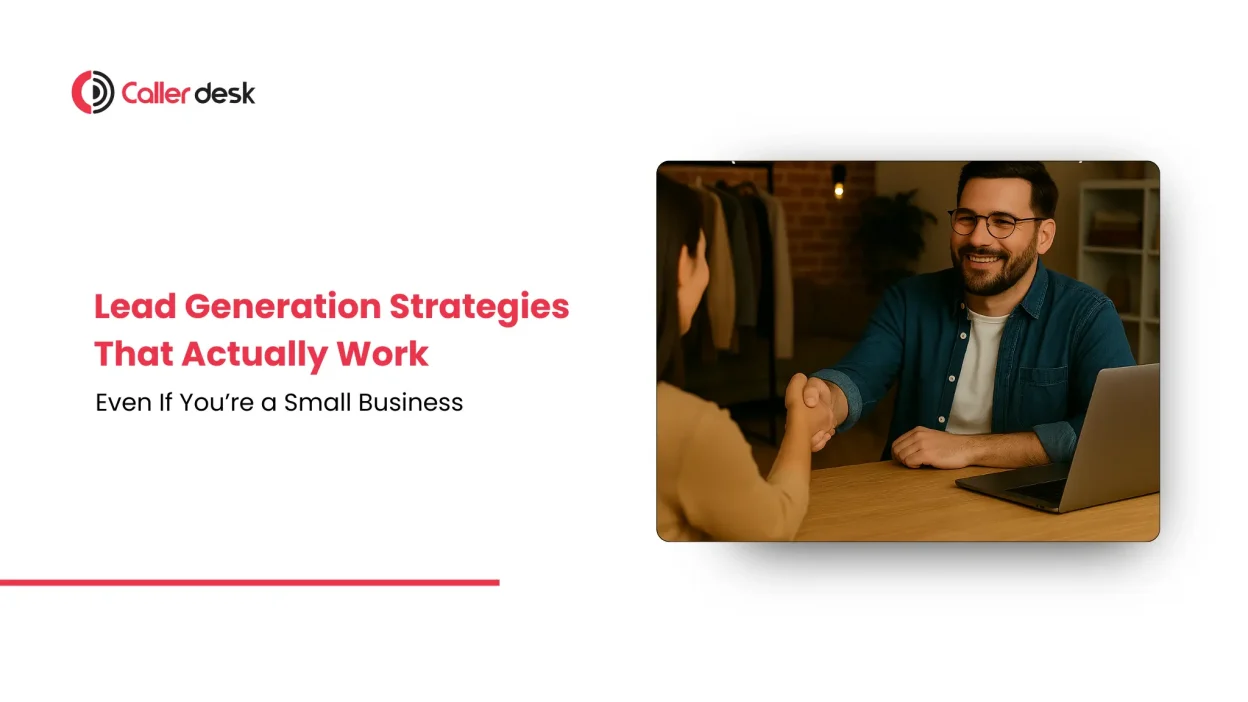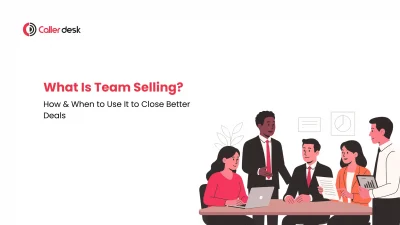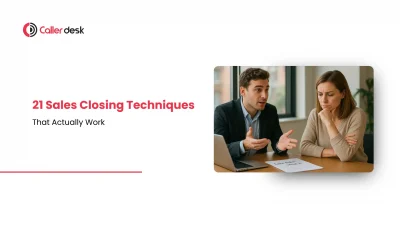If you run a small business, getting more customers is always the goal. But how do you do that?
You start with something called lead generation.
Lead generation is about attracting people who might be a good fit for what your business offers. These people are not your customers yet—but they might become one soon.
Think of it like this: Someone visits your shop, website, or Instagram page. They ask questions or give you their phone number. That person is a lead.
Your job is to stay in touch, answer their questions, and help them make a decision to buy.
This is how businesses grow—by turning leads into customers.
And don’t worry—you don’t need a big team or lots of money. There are many simple and smart ways to get leads, even if you are just starting out.
In this blog, I’ll explain:
- What lead generation really means
- Why it’s important for small businesses
- 9 easy ways to get more leads without spending too much
What Is Lead Generation? (In Simple Words)
Lead generation is the process of getting people interested in your business—and then collecting their contact details so you can talk to them later.
Think of it like this:
When someone finds your ad, browses your site, or views your video, and wants to explore further—that’s the start of a lead. So they give you their:
- Name
- Phone number
- Email address
These people are called leads.
They haven’t bought anything yet, but they’re showing signs that they might in the future. Your goal is to stay in touch, build trust, and help them decide to buy when they’re ready.
A lead can be someone who:
- Fills out a form on your website
- Downloads a free guide or coupon
- Signs up for your newsletter
- Sends you a message on Instagram or WhatsApp
👉 In short:
Lead generation is how you turn strangers into potential customers. It’s like saying, “Hey! I’ve got something that might help you,” and giving them a chance to respond.
Why Does Lead Generation Matter for Small Businesses?
Think of lead generation like planting seeds for your business. If you don’t plant seeds, you won’t grow anything. It’s the same in business—if you don’t get new leads, you won’t get new customers.
And without customers, your business won’t make money or grow.
Let’s look at why lead generation plays a big role in helping small businesses grow:
1. It Brings In People Who Are Curious About Your Offer
Leads are those who have shown some level of interest in what you’re selling—they’re not random visitors. They’ve shown interest—which means they’re more likely to become paying customers.
2. You Have a Better Chance of Making Sales
When you focus on the right leads, you’re not wasting time talking to random people. You’re talking to people who actually need what you offer.
3. You Save Money on Marketing
Instead of spending money showing your ads to everyone, lead generation helps you reach only the right people. That means less spending and better results.
4. You Can Grow Faster
More leads means more customers and more sales. With a steady flow of leads, your business can grow quickly and smoothly—without running after people.
5. You Don’t Need a Big Budget to Start
The best part is that you don’t need a huge budget to begin. Even with free tools and small efforts, you can start seeing results.
9 Lead Generation Strategies That Actually Work
These lead generation ideas are simple, affordable, and perfect for small businesses—even if you’re just getting started. Let’s break each one down clearly.
1. Offer a Freebie That Solves a Real Problem
Everyone loves free stuff—especially when it’s useful. This is called a lead magnet. You give something helpful for free, and in return, you collect their name, email, or phone number.
Great freebie ideas:
- A checklist (like “10 Steps to Clean Skin”)
- A discount coupon (like “15% off your first order”)
- A mini eBook or PDF guide
- A free trial of your service or a demo
Tip: Make sure the freebie is related to what you sell. For example, if you’re a fitness coach, offer a free “7-Day Meal Plan.”
2. Build and Use an Email List
Once you collect people’s email addresses, don’t let them sit idle. Use emails to stay in touch and build trust.
You can send:
- Tips and how-tos
- New product updates
- Special offers and coupons
Why this works: Emails land directly in your customer’s inbox—so it’s personal and direct.
Tools to try: Mailchimp, Sender, or ConvertKit are great for beginners.
3. Write Blogs That Help Your Audience
Blogging is a great way to answer your customer’s questions—and help Google send people to your website.
Popular blog topics could be:
- “How to save money while shopping online”
- “Easy recipes for working parents”
- “What to look for in a skincare product”
Add a form or button at the end of each blog to collect leads:
“Like this post? Subscribe to get more tips.”
Tip: Use free tools like Ubersuggest to find keywords your audience is searching.
4. Use Social Media to Educate and Attract
Don’t just post for likes—post with a purpose.
Social media platforms like Instagram, Facebook, and LinkedIn can help you attract the right audience if you share valuable content.
You can post:
- Customer success stories
- Before-after images
- Quick problem-solving tips
- Behind-the-scenes looks at your business
Always end your post with a clear call-to-action:
“Message us for more info” or “Click the link in bio.”
5. Make Short Videos That Show What You Do
Videos build trust quickly. People prefer to watch rather than read.
What kind of videos work best?
- How-to videos (like “How to fix a leaking tap”)
- Product demos (like “How our face cream works”)
- Customer reviews or testimonials
You can upload videos on Instagram Reels, YouTube, or WhatsApp Status.
End your video with a call-to-action:
“Need this? DM us now” or “Visit our site to book a free call.”
6. Use Local SEO to Show Up in Your Area
If your business depends on local customers (like a gym, salon, or tuition center), make sure they can find you online.
Do these three things:
- Create or update your Google Business Profile
- Add keywords like “Cake shop in Ahmedabad” or “Tutor near me” on your website
- Ask happy customers to leave Google reviews
This helps you appear in Google Maps and “near me” searches.
Tip: This is completely free and easy to set up.
7. Run Simple Paid Ads
Paid ads help you reach more people faster. You don’t need a big budget.
Best platforms for small businesses:
- Facebook and Instagram
- Google Ads
Start with a small amount per day and focus on one clear goal: Get clicks or leads.
Tip: Use retargeting ads to show your ad to people who already visited your website. They are more likely to convert.
8. Host Webinars or Free Online Classes
Want to attract serious leads? Teach them something useful.
Host a live webinar or even a recorded Zoom session. People love free learning and will give their contact info to join.
Webinar ideas by industry:
- For finance: “How to Save Tax as a Freelancer”
- For beauty: “Makeup Basics for Beginners”
- For digital marketing: “Social Media Tips to Get More Customers”
Collect names, emails, or phone numbers during sign-up.
9. Ask Your Happy Customers to Refer Others
One of the easiest ways to get new leads is through your current customers.
Create a referral program that rewards them for bringing in more people.
Examples:
- “Refer a friend and get a discount”
- “Bring two friends and get your next session free”
Make it easy to share—like a WhatsApp message or a short link they can forward.
Don’t Make These Common Lead Generation Mistakes
Even if you’re using good lead generation strategies, a few small mistakes can reduce your results. Here’s what to avoid:
1. Asking for Too Much Information
If your form asks for too many details, people may leave without signing up.
Just ask for what you really need in the beginning—usually a name and email address. You can collect more details later, once they trust your business.
2. Not Following Up with Leads
Many businesses lose leads by simply not following up.
If someone shows interest, always send a follow-up message. Say thank you, remind them of your offer, or share something helpful. A simple follow-up builds trust and brings people closer to buying.
3. Trying to Talk to Everyone
Not everyone is your ideal customer. If your message is too general, it won’t connect with the right people.
Focus on your target audience. Understand who they are, what they need, and how you can solve their problem. That’s how you turn attention into action.
4. Not Tracking What’s Working
If you don’t track your lead generation activities, you won’t know what’s actually helping your business grow.
Track results like:
- Which ads get the most clicks
- Which blog posts bring in signups
- Which emails get replies
This helps you stop doing what doesn’t work and spend more time on what does.
Conclusion
Lead generation is the key to growing your small business. With the right strategies—like offering freebies, using email, posting helpful content, and focusing on your audience—you can attract leads without spending too much.
Start small, be consistent, and avoid common mistakes.
And if you want to manage leads better, CallerDesk is the best cloud telephony provider in India—helping you track, route, and follow up with every call, all in one place.
Ready to grow smarter? Try CallerDesk today.



